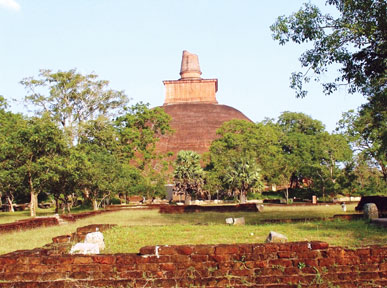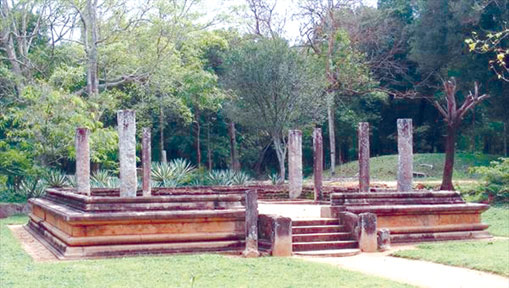|
Today is Bak Poya:
Buddhism promotes environmental conservation
by Ven. Gnanapala Sri Vajirarama Temple Colombo
 |
|
Jethavanarama |
The Ancient sages have laid down certain rules for planting trees.
They always saw to it that houses were surrounded by gardens containing
a variety of trees and plants, decorative and herbal.
The Vrikshayurveda contains scientific methods of preserving and
treatment of seeds, methods of irrigation, location of ground water,
nourishment and fertilisers, raising of orchards and sustainable
horticultural production.
The science of plant biology was founded in vedic times, in the Agni
Purana and Varaha Purana are names of trees which a man should cultivate
in his lifetime. These scientific treatises produced by the ancients
have baffled even modern researches.
Kautiliya in his treatise on economics asserts that the royal park
warden should be a scientist proficient in botany and rukshayurveda or,
the science of maintaining the health and life of trees. That plant life
and human life are parallel and complimentary in many aspects was a
confirmed view of the ancient Rishis.
Benefits
The Agni Purana also explains similar benefits. Trees provide endless
joy to all gods, gandharvas, asuras, kinnaras, nagas, birds animals, and
all human beings.
Long before the Westerners thought of ecological balances these good
practices had come down from ancient Aryan times, upto the Asokan era.
Sri Lanka's historical record shows that the first conservation park
was set up some two thousands years ago in the Anuradhapura area, from
the times of the ancient Sinhala kings. Environmental conservation and
concern have been of special significance.
Buddhism made Lanka more beautiful. The Chronicles and inscriptions
contain numerous references to parks and gardens. Special care was
bestowed on the growing of medicinal herbs. Flowering plants were grown
for making offerings to the Buddha.
Pleasure gardens
Anuradhapura's Nandana and Mahamevna parks were two pleasure gardens
of our glorious past. That the Sinhalese were well versed in
horticulture, agriculture and irrigation technology is evident from the
ancient ruins and chronicles such as the Mahavamsa. Beautiful public
parks once adorned Sri Lanka's ancient cities, for both king and
commoner. Vast glades and forest reserves were maintained for the
benefit of monks and ascetics as well as for the protection of our
fauna.
The Chinese monk Fa-Hsien in describing his visit to Anuradhapura in
the fourth century dwells with administration and wonder at the sight of
the innumerable gardens for the floral requirements of the temples. The
capital was surrounded on all sides by flower gardens, and these were
multiplied so extensively, that, according to the Rajaratnakara, they
were to be found within a distance of four leagues in any part of Sri
Lanka.
Another advantage conferred by Buddhism on the country was the
planting of fruit trees and vegetables for the use of travellers in all
the frequented parts of the island.
 |
|
Mahamevna |
Five centuries before the birth of Christ Arahat Mahinda son of
emperor Asoka told king Devanampiyatissa. "O great king! the birds of
the air and beasts have an equal right to live and move about in any
part of the land as though the land belongs to the people and all other
beings. Thou art only the guardian of it. The time has therefore come
for us not only to live in harmony with birds and beasts but also with
the earth's resources, the water on which our very existence depends."
The Buddha preached in the Vanaropana Sutta that the forest with its
unlimited kindness and benevolence does not demand it sustenance and
extends generously its produce during its lifetime. It gives protection
to all beings, even shade to the axeman who destroys it.
Inspiration
In India, King Asoka asked his people not to burn the forests. His
example of planting herbs and trees is an inspiration to the whole
world. Asoka's sagacity was also shown in his efforts to cultivate
medicinal herbs in his own and other countries. During war, trees were
not destroyed. They neither ravaged an enemy's land with fire nor cut
down its trees.Recent excavations in Sigiriya have revealed one of the
oldest surviving example of Asia's ancient art of landscape gardening in
Sri Lanka.
The western area has three distinct garden systems: symmetrical water
gardens and symmetrical boulder gardens stepped and embanked terrace
gardens encircling the base of the rock. Also recent excavations have
revealed an intricately laid out micro water garden system of an unknown
type.
Instruction and practices pertaining to trees have come to us from
vedic times, and Westerners will be surprised how voluminous
instructions have been enshrined in the Rigveda and Purana because trees
and plants give us food, clothing, shelter, medicine, wisdom and
happiness.
The Buddha has stressed the need for close contact with nature and
pointed out how advancement of the mind leads to a greater appreciation
of nature. We in Sri Lanka have a special responsibility towards
protecting the natural environment.
This is so because the conservation of natural resources and living
in harmony with the environment are a part and parcel of the Buddhist
way of life.
|

